-
Posts
5,391 -
Joined
-
Last visited
-
Days Won
3
Content Type
Profiles
Forums
Blogs
Gallery
Events
Store
Posts posted by Gordon Williamson
-
-
Yup, an unmarked piece from before the advent of the LDO could be just about anything. Even after the LDO and its marking regulations appeared, there were clearly many firms which ignored them ( ever seen a Schwerin KM War Badge with an L/ mark ? ). One thing you can be sure of though is that if a piece does carry an LDO mark then officially, it was a Copy. Even with the 40s manufactured replacement 1914 EKs a piece supplied as an official replacement would have the Präsidialkanzlei mark and would be a real "official", the identical badge award bz the same maker purchased retail would be LDO marked and thus, a Copy.
One of the reasons I never had much liking for badges with an LDO mark - with only a few rare exceptions in high awards like the RK, they were copies bought "over the counter", not an official award earned in battle.
 0
0 -
Using Speedy's logic, should all our LDO production WW1 awards be considered "copies" :-) ?????
That was my point. They were copies. Legitimate copies, but copies nevertheless. The original wartime catalogue referred to LDO marked pieces as "Nachbildungen" -- "Reproductions", or "Copies"
In today's collector-speak "Copy" is a derogatory term, but even back then, the Germans considered LDO pieces as Copies. Identical in every way to the official award for sure but for the LDO mark, but if intended for retail sale as opposed to an official award piece, they were considered a Copy.
0 -
This ruling was further clarified by Appendix 13/8, which specifically referred to all grades of the Knight's Cross of the Iron Cross 1939.
Is there any mention of "in seinen Stufen" other than in Anlage 13/8.
Looks to me like the mention comes in a section (6) dealing specifically with the order of priority in which awards are shown on the Bandschnallen and would thus relate to the miniatures of these awards.
As the RK with oaks or with oaks Swords in miniature are one piece stampings, with the oaks etc integral to the cross these would of course be 1957er pieces so effectively there were 57 type EL and ELS even if in miniature for the Bandschnalle.
Seems to me like an awful lot of argument here over semantics.
There would be no need to specifically include the Oaks and Oaks/Swords in the "Beilage zum Bundesanzeiger 41" as there was no need to change the design. So there may well not have been a specifically approved 1957 "pattern" Oaks etc but obviously there was no prohibition on people like S&L using their old wartime tooling to produce new example to sell with their 1957er RK.
I can see both sides of the argument here.
There are several cases where there was no need for the award to be redesigned and included in the list of approved "new form" awards, and so were not included in "Beilage zum Bundesanzeiger 41". However, the manufacture of these was permitted and they were made alongside the "true" 57ers and often used the same pins, fittings etc.
So Uwe is probably strictly correct by saying these are not official 57 "pattern" awards, and thus are "copies" (not necessarily a "dirty" word, bear in mind even the original wartime S&L catalogue does in fact refer to their LDO marked pieces as "copies" - legitimate, approved, but not official awards) but to collectors they were made alongside the 57ers, to be worn with the 57ers so it is not suprising that to most who collector the denazified awards that these too are considered as 1957ers.
0 -
Nice boards for the white summer tunic !
0 -
Sorry Dan, but I think that is very unlikely. I would be 99% certain that it is the Stammrollnummer. I have had several KM badges over the years with such numbers added.
0 -
Peter is correct, his is an NCO cap, but one which has been altered for use by an officer. Officer caps have the peak covered with blue cloth.
Peter, am I right in assuming the stiffener inside the cap band is celluloid material rather than the pasteboard / card type material you find in Army/Luft caps.
Looks like a nice original , modified, cap.
1 -
Can you post a pic with the white top removed. Ideally, on original caps there should be a white "cheesecloth" type gauze material covering the inner face of the liner, like this,
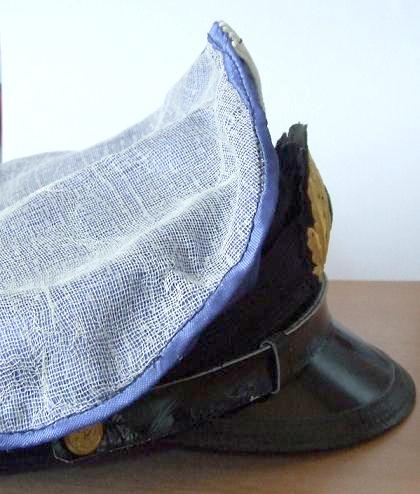 0
0 -
Just came across this photo which seems to show the same style Gorget being worn, so not just a "one-of" piece after all.
The style of field caps, lack of any wartime decorations etc suggests this is an early, pre-war shot.
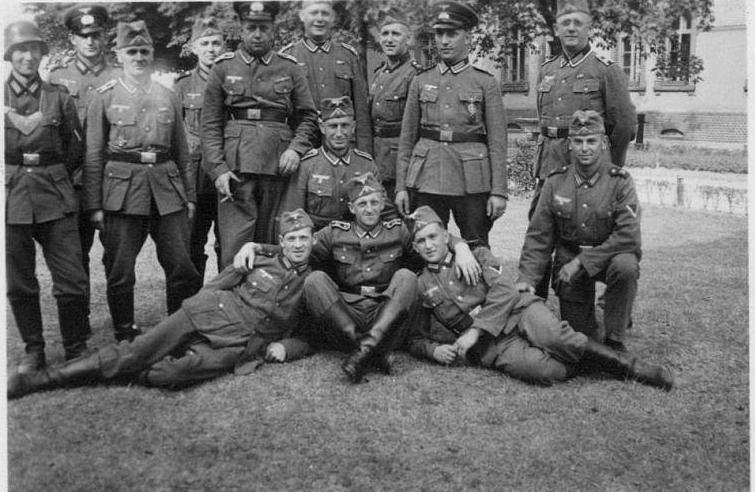
 0
0 -
Things are progressing. The base is now boxed in with mahogany with brass corners. The sea has been painted and varnished. All the portholes have been added ( every single porthole is formed from a brass tube inserted into a drilled hole in the hull side).
The sea looked good until I added the varnish and the colour changed, so I will probably do this again as I think it looks too "blue". The North Atlantic looks more grey than blue !
All the superstructure parts are just sitting there for the photo but once the decking is added things will begin to move faster.
 0
0 -
Heres a comparison shot showing the weave on the Fg cuffband with the weave on a Waffen-SS Danmark cuffband.
 0
0 -
Bob
It was a trick question. I deliberately used the term SS "type". Of course the SS-Feldgendarmerie was the second type used by the Waffen-SS, but before the introduction of this pattern, they used the regular brown Feldgendarmerie band, but what I was getting at was the weave style of the brown one. It is an extremely rare variant, and if you look closely you'll see it is in fact of the identical weave style as the Waffen-SS cufftitles for Norge, Danmark and Hitlerjugend cufftitles, clearly made by the same firm.
So the answer to my question was realy both of them are SS "type". Both were used by the Waffen-SS and the brown one is in a weave style so far only seen for three SS bands plus this Fg variant. :D
0 -
And here's the same badge, different hinge, but same retaining hook, same crappy ragged finish to the cut out under the submarine - and maker stamped "3" for Deumer.
Now, it sure as heck isn't a Deumer, so if the "3" marked version is bad, what does that say for the chances of a "53"
I thought they were pretty convincing first time I saw them. Easy to see how someone would be taken in by them, but I certainly wouldn't trust a "53" now.
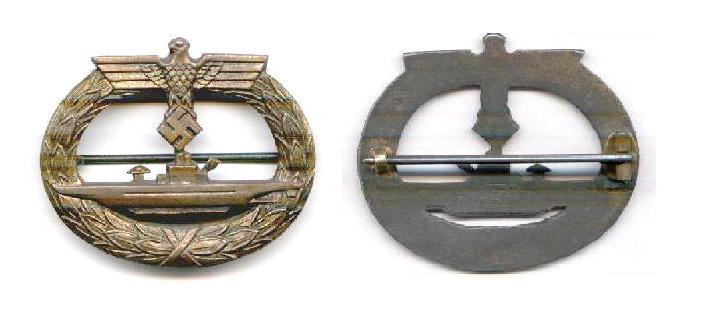 0
0 -
Here is the "53" badge. Sorry for the quality of these images, rescued from an ancient floppy disc.
 0
0 -
I have been asked before why I don't like these.
Well, apart from the fact that I saw a German dealer offering these, with the Swastika drilled out to take small stones, as replicas of the U-Boat Badge with Diamonds (and why would someone take a genuine badge, screw it up by adding fake stones to the Swastika, then sell it at half what a standard genuine badge would have fetched in the first place), there is this.
Here we have a reverse view of the standard, Zinc badge by Deumer, well known and universally accepted.
 0
0 -
Here's a question for the cloth insignia buffs. Which of these is an SS type cuffband.
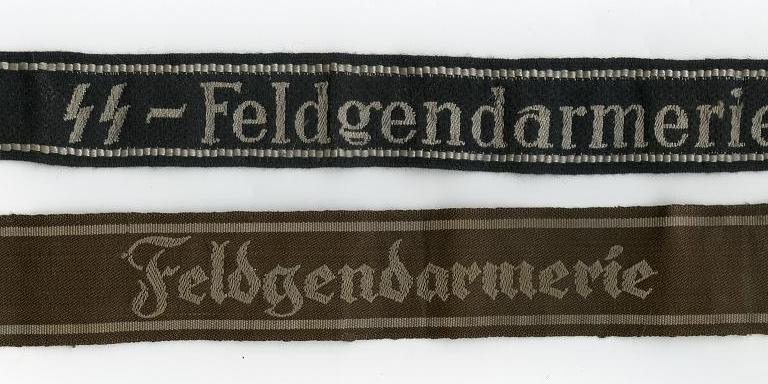
 0
0 -
The difference in shape is even more obvious from the reverse, the letters being softer and more curved along thier outline on the fake.
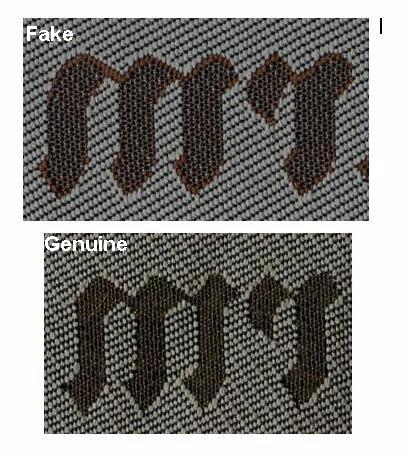 0
0 -
The letters are far less crisply defined on the fake. Note also the gap betweem the letters "r" and "m"
 0
0 -
First give away on the fakes is the material itself, which is too stiff, and does not pass the burn test. However, on the basis that they may change to using correct rayon type thread, there are more obvious differences.
Note the weave patterns. The weave on the Fake runs very distinctly from top right to bottom left, whilst on the genuine piece, though not quite so distinct, it is from top left to bottom right.
 1
1 -
Reverse, this time with the genuine example on top.
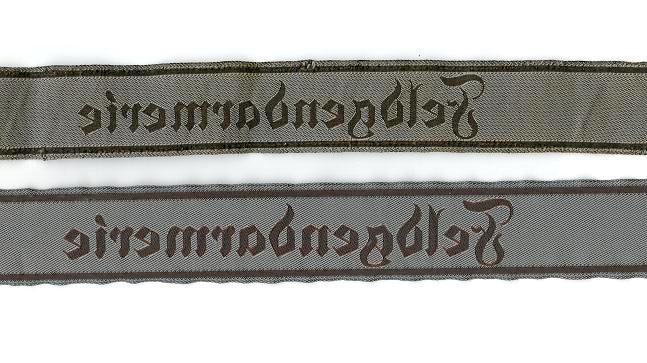 0
0 -
There are three distinct weave patterns known for genuine period manufactured Feldgendarmerie cuffbands and sadly, one of these has been labelled "fake" on Forums due to ignorance of the fact that the fakes of this type were based on a genuine pattern.
Shouldn't complain really as I got my genuine example cheap from an auction, presumably because others were put off by assertions that this type was suspect.

Here is an obverse view, the fake being on top.
 0
0 -
Best bargain I have seen for a long time Jan Arne. Nice piece !
0 -
Your collection is coming along very nicely. You got hold of quite a few real nice tallies in a short space of time. Well done !
0 -
U-Boat Tender Lech
 0
0 -
U-Boat Tender Acheron
 0
0




Oakleaves... good or bad?
in Germany: All Eras: The Iron Cross
Posted
I quite agree. Neither the 1941 produced 1914 EK or the Oakleaves produced by S&L on the original tools after 1945 can be originals. They are Copies. The 1941 produced 1914 EK can be described as a "period" Copy (different to a modern fake), but it is still a Copy.
Simple. It is a Copy. Original design, made on original tools. But is is a Copy.
I don't understand your point. If it was not forbidden, then surely by default it is permitted. It does not have to be written down in law that it is permitted. We do not have laws which tell us what we can do, more likely to tell us what we cannot do. We don't have a law to say we can buy a car, we have a law to say we cannot steal a car.
There were several Third Reich decorations which were forbidden, even in de-nazified form. If an award, like the Oakleaves, was not specifically forbidden, then surely it was permitted. Not, perhaps as an authorised "1957 type", but still permitted to be made.
Do you know of a regulation to say it was NOT permitted to make Oakleaves after 1957?
I think we agree more than we disagree, but perhaps it is a matter of definitions.
To be clear, for me if an award, such as the Oakleaves made by S&L, was manufactured after 1945, it is a Copy or Restrike made on the original tools, which because there was no forbidden NS emblem in the design, could be worn with the 1957 RK.
For sure, to me - and I think to most collectors, a nice early postwar set of S&L Oakleaves even if defined as a "Copy" would certainly be more desirable than a modern "true" 57er RK made in the 1980s